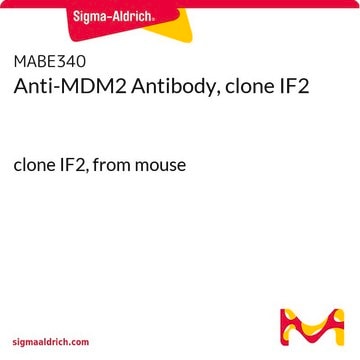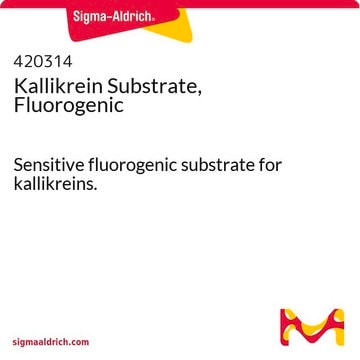OP46
Anti-MDM2 (Ab-1) Mouse mAb (IF2)
liquid, clone IF2, Calbiochem®
Synonyme(s) :
Anti-Murine Double Minute Chromosome-2, Anti-Ubiquitin Protein Ligase, Anti-p53 Binding Protein, Anti-Ubiquitin Protein Ligase, Anti-p53 Binding Protein, Anti-Murine Double Minute Chromosome-2
About This Item
Produits recommandés
Source biologique
mouse
Niveau de qualité
Forme d'anticorps
purified antibody
Type de produit anticorps
primary antibodies
Clone
IF2, monoclonal
Forme
liquid
Contient
≤0.1% sodium azide as preservative (100 μg only)
Espèces réactives
human
Ne doit pas réagir avec
mouse
Fabricant/nom de marque
Calbiochem®
Conditions de stockage
do not freeze
Isotype
IgG2b
Conditions d'expédition
wet ice
Température de stockage
2-8°C
Modification post-traductionnelle de la cible
unmodified
Informations sur le gène
human ... MDM2(4193)
mouse ... Mdm2(17246)
Description générale
Immunogène
Application
Immunoblotting (0.5-2 µg/ml, chemiluminescence)
Immunofluorescence (1-5 µg/ml)
Immunoprecipitation (1 µg/sample)
Paraffin Sections (1-5 µg/ml, heat pre-treatment required, see application references)
Conditionnement
Avertissement
Forme physique
Remarque sur l'analyse
OSA-CL cells
Autres remarques
Immunoblotting Protocol
MDM2 (Ab-1) can be used to detect MDM2 by Western blot of proteins previously separated by SDS/PAGE and electrophoretically transferred onto nitrocellulose membranes. The proteins are reacted with the monoclonal antibody and visualized using an HRP conjugated goat anti-mouse antibody with chemiluminescent detection.
Materials
Equipment:
• Electrophoresis apparatus
• Electroblotting apparatus
• Rocker platform
Solutions and Reagents
• Anti-MDM2 (Ab-1) Mouse mAb (IF2) Cat. No. OP46 or OP46T
• HRP conjugated goat anti-mouse IgG heavy and light chains (e.g. Cat. No. 401215)
• Chemiluminescence detection system
• ELB Buffer (include a cocktail of proetease inhibitors, such as 0.5 µg/ml leupeptin, 1 µg/ml pepstatin, 1 mM EDTA and 0.2 mM PMSF): 50 mM Hepes pH 7.0, 250 mM NaCl, 0.5 mM EDTA, 0.1% Nonidet P-40 Alternative
• SDS-PAGE (7% acrylamide)
• Phosphate buffered saline (PBS) pH 7.4; 1 Liter: 0.2 g KCl, 0.2 g KH2PO4, 8 g NaCl, 1.15 g Na2HPO4
• PBS/0.1% Tween®-20 detergent (PBST)
• 3% Non-fat Dry Milk in PBST
Procedure
1. Lyse cells in ELB Buffer. (Alternatively, cells can be lysed in RIPA Buffer or directly into 1x Laemmli Sample Buffer).
2. Electrophorese 50-100 µg lysate using a 7% acrylamide gel.
3. Transfer the protein samples from the polyacrylamide gel onto a nitrocellulose membrane using an electroblotting apparatus.
4. Block the membrane for 1 h in PBST containing 3% non-fat dry milk at room temperature with rocking. Use about 1 ml per cm2 of membrane.
5. Incubate the membrane with 1 µg/ml Anti-MDM2 (Ab-1) Mouse mAb (IF2) in 3% non-fat dry milk/ PBST for 1 h at room temperature with rocking.
6. Wash the membrane 3 times, 15 min each, in PBST at room temperature with rocking.
7. Incubate the membrane with HRP conjugated goat anti-mouse IgG heavy and light chain antibody, diluted according to the supplier’s instructions, in 3% non-fat dry milk/ PBST at room temperature for 1 h.
8. Wash the membrane 4 times, 15 min each, in PBST at room temperature with rocking.
9. Develop the membrane using chemiluminescent detection reagents according to manufacturer instructions.
10. Expose the membrane to film for ten minutes. Adjust subsequent exposure times as needed.
Marchetti, A., et al. 1995. J. Pathol.175, 31.
Barak, Y., et al. 1993. EMBO J.12, 461.
Ladanyi, M., et al. 1993. Cancer Res.53, 16.
Leach, F.S., et al. 1993. Cancer Res.53, 2231.
Oliner, J.D., et al. 1993. Nature362, 857.
Momand, J., et al. 1992. Cell69, 1237.
Oliner, J.D., et al. 1992. Nature358, 80.
Fakharzadeh, S.S., et al. 1991. EMBO J. 10, 1565.
Informations légales
Not finding the right product?
Try our Outil de sélection de produits.
Code de la classe de stockage
10 - Combustible liquids
Classe de danger pour l'eau (WGK)
nwg
Point d'éclair (°F)
Not applicable
Point d'éclair (°C)
Not applicable
Certificats d'analyse (COA)
Recherchez un Certificats d'analyse (COA) en saisissant le numéro de lot du produit. Les numéros de lot figurent sur l'étiquette du produit après les mots "Lot" ou "Batch".
Déjà en possession de ce produit ?
Retrouvez la documentation relative aux produits que vous avez récemment achetés dans la Bibliothèque de documents.
Notre équipe de scientifiques dispose d'une expérience dans tous les secteurs de la recherche, notamment en sciences de la vie, science des matériaux, synthèse chimique, chromatographie, analyse et dans de nombreux autres domaines..
Contacter notre Service technique






